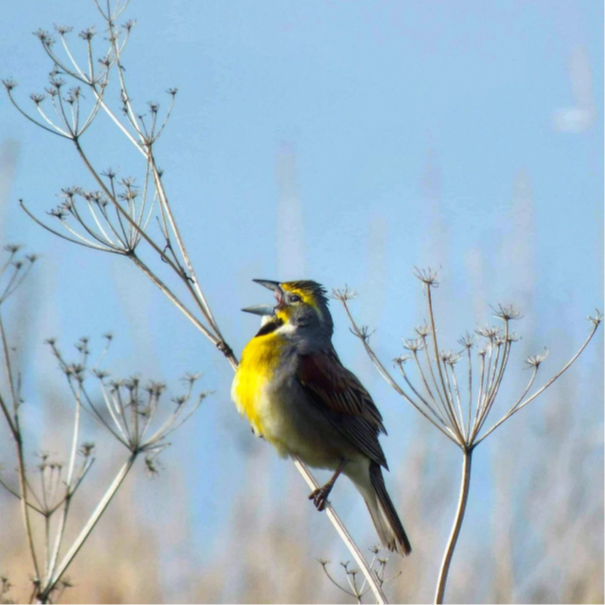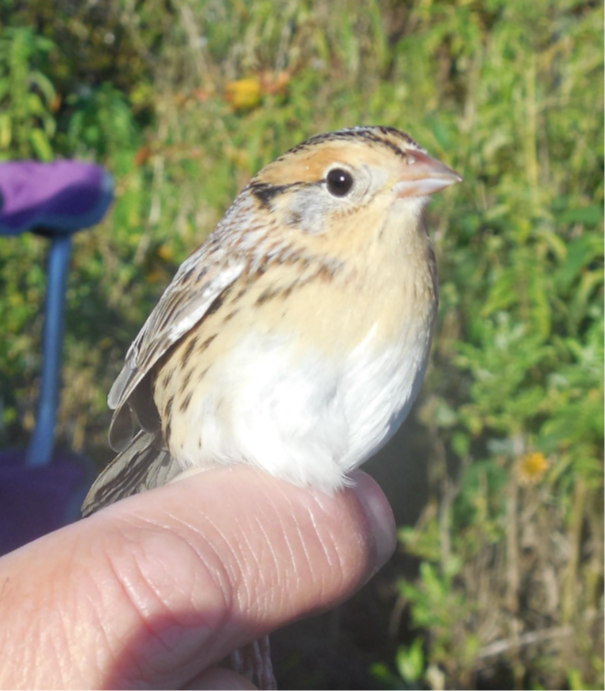By: David Swanson
North American grasslands are among the most endangered ecosystems on the continent1. This is particularly true for tallgrass prairie habitats, like Spirit Mound, which historically covered much of the eastern third of South Dakota but have now been mostly converted to row crops and other agricultural habitats. Some estimates suggest that only about 1% of the original North American tallgrass prairie remains. Due, in part, to this decline in grasslands in North America, grassland birds are showing the greatest population declines of any bird guild on the continent2,3. Most birds breeding in North American grasslands are migrants. Conservation of migratory birds is complicated by habitat requirements throughout the annual cycle, such that threats to grassland birds could occur not only on the breeding grounds, but also on the wintering grounds or along the migratory route4. Loss or degradation of grassland habitats during any or all of these stages of the annual cycle of grassland birds could potentially act to limit grassland bird populations.
Grassland bird biodiversity and abundance at Spirit Mound may also be declining, perhaps as a function of the large-scale reductions and degradation of grassland habitats across the Americas. One study5 of breeding grassland birds Spirit Mound during the summer of 2003 detected 34 grassland birds and generated population abundance estimates for these species. This study was repeated during the summer of 20136, but this latter study only detected 20 species of grassland birds, and population abundances of 11 of these 20 species of grassland birds, including Upland Sandpiper, Horned Lark, Vesper Sparrow, Grasshopper Sparrow, Dickcissel, and Western Meadowlark, had declined over the 10-year interval. Stable population densities, however, occurred for Ring-necked Pheasant, Sedge Wren, Common Yellowthroat, and Bobolink. Differences in grassland bird biodiversity and abundance could have resulted from differences in weather among years (drier in 2013) or from changes (i.e., maturation) in the grasslands at Spirit Mound6, but these population trends are consistent with larger-scale population declines in grassland birds2,3, suggesting that changes occurring at continental or inter-continental scales may also be involved.
The news, however, is not all bad for grassland birds at Spirit Mound. Amy West recently completed a Master’s thesis studying migrant bird use of the grasslands at Spirit Mound and other grasslands in Clay County, South Dakota7. During surveys of grasslands conducted three times per week during the spring (April and May) and Fall (September and October) migration seasons, this study detected 69 bird species in spring and 92 in fall. These birds included not only grassland species, but also some species characteristic of woodlands and shrublands, which also occurred on the grasslands during the migration seasons. The number of bird species detected was higher at reconstructed native prairies, including Spirit Mound, than at Conservation Reserve Program or other managed grassland habitats at both seasons. Overall bird abundances on the grasslands were positively associated with reduced grass cover and bare ground, which are attractive to some grassland bird species. This study also used blood metabolite profiling, from small blood samples collected from some of the birds, to assess how successfully migratory birds were adding fat to fuel the next leg of the migratory journey. These birds showed plasma metabolite levels consistent with high-quality habitat, suggesting that Spirit Mound provides high-quality habitat for refueling between successive stages of migration. For the few birds that were captured again at least one day after their initial capture, these birds also generally showed increases in body mass, also suggesting that birds were successfully adding fat at Spirit Mound. This is one of the very few studies to examine grasslands as migratory stopover habitat and it suggests that reconstructed tallgrass prairies, like Spirit Mound, can serve as suitable migration habitat for grassland birds, which provides a critical link in the conservation of these birds.
Another recent study8 used bird count data from across the Upper Missouri River Basin, in North and South Dakota, Wyoming and Montana, to quantify habitat associations and project population changes in 24 species of grassland birds under a variety of future scenarios emphasizing current agricultural practices, increased bioenergy production, or conservation. This study found that the most important predictors of current grassland bird abundance included distance to woodland (abundance increased away from woodland edges), mean winter and summer temperatures, and elevation. Under future scenarios, climate change was generally a more important predictor than land use change, and most species of grassland birds in the region are projected to show increases in population abundance in the future. Population abundance, however, did not change uniformly across the region, as most areas of increasing population abundance occurred in the western portion of the region and at higher elevations. Areas of current highest population densities for grassland birds in the region were uniformly areas where abundances are predicted to decline, as populations shift westward and to higher elevations. The projections are not all positive, however, as some bird species are projected to show future population declines in the region under at least some scenarios. These species include Greater Sage-Grouse, Long-billed Curlew, Lark Bunting and Savannah and Vesper sparrows.
To sum up, Spirit Mound and other similar tallgrass prairie habitats serve as valuable habitats for breeding and migrating grassland birds. Such habitats are rare but serve critically important roles in the conservation of grassland bird species. Management practices that place more grasslands on the landscape in the northern Great Plains are sure to benefit grassland birds throughout the breeding and migratory phases of their life cycles.
References:
1. Jarchow, M.E., D.L. Swanson and J.L Kerby. 2020. North American grasslands as multifunctional landscapes. In: Leal Filho W., Azul A., Brandli L., Lange Salvia A., Wall T. (eds). Life on Land. Encyclopedia of the UN Sustainable Development Goals. Springer Nature, Switzerland. DOI: https://doi.org/10.1007/978-3-319-71065-5_123-1.
2. Schipper, A. M., J. Belmaker, M. D. de Miranda, L. M. Navarro, K. Böhning-Gaese, M. J. Costello, M. Dornelas, R. Foppen, J. Hortal, M. A. J. Huijbregts, B. Martín-López, N. Pettorelli, C. Queiroz, A. G. Rossberg, L. Santini, K. Schiffers, Z. J. N. Steinmann, P. Visconti, C. Rondinini, and H. M. Pereira. 2016. Contrasting changes in the abundance and diversity of North American bird assemblages from 1971 to 2010. Global Change Biology 22:3948-3959.
3. Rosenberg, K. V., A. M. Dokter, P. J. Blancher, J. R. Sauer, A. C. Smith, P. A. Smith, J. C. Stanton, A. Panjabi, L. Helft, and M. Parr. 2019. Decline of the North American avifauna. Science 366:120-124.
4. Stoy, P.C., S. Ahmed, M. Jarchow, B. Rashford, D. Swanson, S. Albeke, G. Bromley, E.N.J. Brookshire, M.D. Dixon, J. Haggerty, P. Miller, B. Peyton, A. Royem, T. Sohl, L. Spangler, C. Staub, and B. Poulter. 2018. Opportunities and tradeoffs between BECCS and food, water, energy, biodiversity and social systems at regional scales. Bioscience 68:100-111. DOI: 10.1093/biosci/bix145.
5. Carlisle, J. D., H. Hoff, and P. Mabee. 2004a. Breeding bird inventory of Spirit Mound Historic Prairie in Clay County- an area being restored to tallgrass prairie. South Dakota Bird Notes 56:32-35.
6. Soluk, E. L., M. E. Jarchow, and J. D. Carlisle. 2016. Declines in prairie bird populations in a restored tallgrass prairie. South Dakota Bird Notes 68:85-93.
7. West, A. 2020. Stopover biology of grassland migrant birds. M.S. Thesis, University of South Dakota, Vermillion, SD.
8. Baltensperger, A., M.D. Dixon, and D.L. Swanson. 2020. Implications of future climate- and land-change scenarios on grassland bird abundance and biodiversity in the upper Missouri River Basin. Landscape Ecology 35:1757-1773. https://doi.org/10.1007/s10980-020-01050-4.

